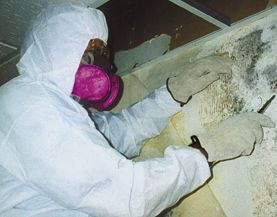Mold Remediation
When it comes to remediating mold it's always best to hire a professional mold removal and remediation service.However, if the mold in your home is not toxic and the area of mold growth is small (less than 10 square feet, or the equivalent of roughly a 3 by 3 foot patch) then you can perform the mold remediation yourself if you wish.
Mold Remediation Overview
The main steps in mold remediation and abatement are:- Wear protective equipment
- Contain mold spores
- Set up negative pressure
- Remove the mold
- Prevent mold returning
- Clean belongings
- HEPA vacuum
- Dispose of the mold
Protective Equipment for Mold Remediation

This is why you should wear protective clothing and equipment while performing mold remediation.
Protective equipment for mold remediation includes:
- Dust filter mask or respirator
- Goggles
- Gloves
- Protective clothing that covers your whole body and can be easily cleaned or disposed of
You should decide how much protective equipment you need to use depending on how severe the mold problem is.
Contain Mold Spores During Remediation
If you need to remove a large amount of mold then you may decide to seal off the room to prevent any mold spores from spreading to the rest of the house. To seal off the room you are about to clean use plastic sheets with duct tape to cover doorways, vents and any other openings.You also need to minimize dust as mold spores often stick to dust and are then transported around your home by the dust particles.
Negative Pressure While Removing Mold
You may also wish to use negative pressure in the room you are cleaning. To do this run an exhaust fan blowing out of a window, or partially opened door if you have to, to blow air outside of the house. This way mold spores that are stirred up during the removal process should mostly end up outside. Also make sure you turn off any air conditioning systems in the house before you begin cleaning up the mold.Removing the Mold
During the mold removal is the time when mold spores are most likely to be stirred up into the air. To reduce this you should begin my moistening any dry mold growth as dry mold will allow many more spores to escape into the air when disturbed. Use a spray bottle of water to wet the dry mold slightly.After this use a solution to remove the mold from the surface. Different solutions will work better for different surfaces.
The Mold Removal page describes how to kill mold with several solutions such as:
- Bleach
- Borax
- Vinegar
- Ammonia
Prevent Mold Returning After Remediation
Next use a mold killing solution to clean surfaces that had mold growth and even surfaces which were free of mold, because all of the surfaces in the room will have some amount of mold spores on them. These mold spores can grow into mold later if moisture accumulates in the room again so killing them will help prevent the mold coming back.Cleaning Moldy Belongings and Materials
Non-porous materials (eg glass, metal, hard plastic) that once had mold on them can be used again after you have completely cleaned the visible mold from the surface. Because the materials are non-porous there will be no more mold below the surface so cleaning the surface mold will take care of the problem.For porous materials (eg drywall, carpet, books) that have had mold growing on them you should decide whether they are salvageable on a case by case basis depending on how severe the mold growth is and how valuable the item is to you. If the item is not highly valuable to you and the mold growth is extensive so that the item is beyond repair then the best option is to dispose of it and replace it.
HEPA Vacuuming
After you have removed the mold and disinfected the surfaces allow them to dry completely. Once everything is completely dry vacuum the room with a HEPA filtered vacuum cleaner to remove any residual spores and mold. To find out more about vacuum cleaners and mold go to Vacuuming Mold.Disposing of the Mold
After the clean up process remove mold and moldy items, as well as the contents of the HEPA vacuum cleaner, from your home in completely sealed plastic bags. If possible do not take the plastic bags through the house but pass them directly to the outside through a window in the room or a door.You should clean each room one at a time, completely finishing the mold removal process before moving onto any other rooms with mold growth and re-sealing and repeating the process.


